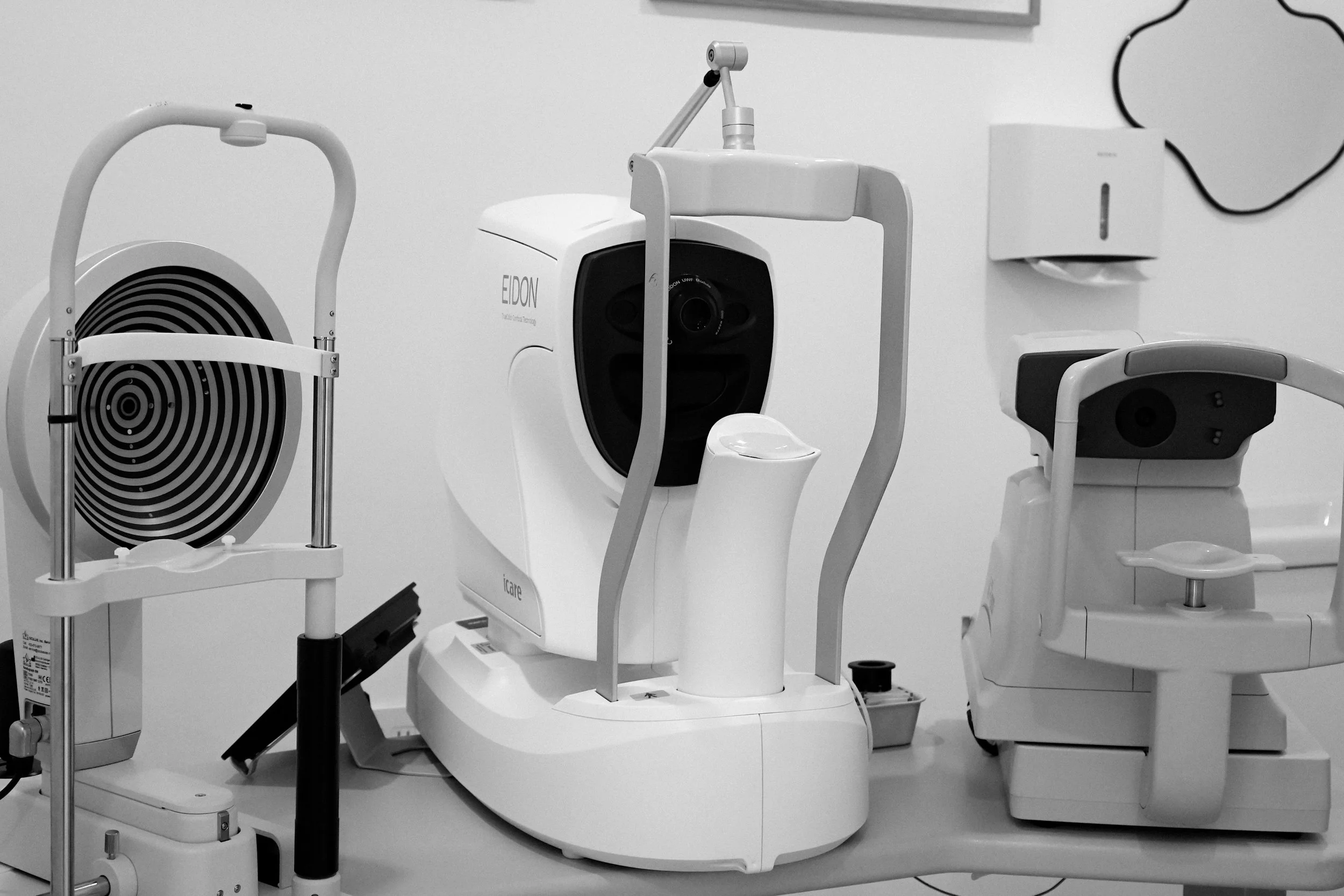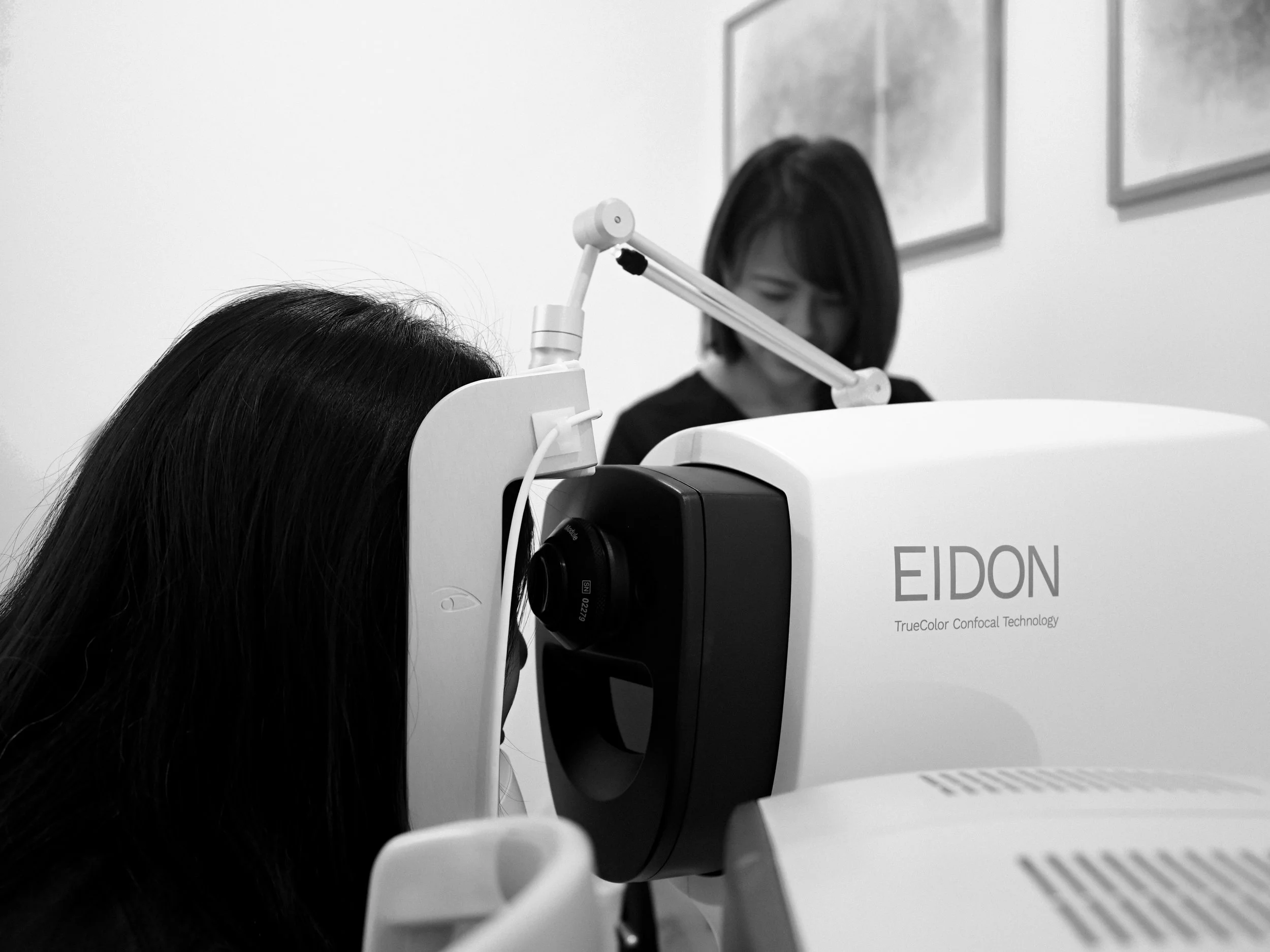Personalized Eye Exams for All Ages
Comprehensive Eye Exam
A comprehensive eye exam is a crucial component of maintaining good eye health. During the exam, we assess the overall health of the eyes, check for any signs of eye diseases like glaucoma or macular degeneration, and evaluate visual acuity to determine if a prescription for glasses or contact lenses is needed. Additionally, we perform tests to assess eye coordination, depth perception, and focusing abilities. Through a comprehensive eye exam, we can detect early signs of eye conditions and provide necessary interventions to preserve and protect your vision for years to come.
Adults should have an eye exam every 1-2 years, depending on any existing vision problems, eye conditions, or if they have been diagnosed with significant risk factors, such as diabetes, high blood pressure, thyroid disease, previous eye injuries, or a concerning family history of eye diseases. The eye care doctor will carefully recommend a frequency for routine follow-up exams based on the patient’s specific medical and ocular history.
Pediatric Eye Exam
During a pediatric eye exam, we thoroughly assess a child's vision, eye health, and eye teaming skills. We use specialized tests to determine if the child needs glasses and to check for any eye conditions that may affect their vision or ocular health. Early detection of eye problems in children is crucial for proper visual development and academic performance. We also provide guidance on proper eye care, including recommendations for screen time management and outdoor activities to help prevent myopia progression. According to the American Optometric Association (AOA) children should have their eye examined by an eye doctor at 6 months, 3 years, at the start of school, and then at least every 2 years following. If there are any signs that there may be a vision problem or if the children has certain risk factors (such as developmental delays, premature birth, crossed or lazy eyes, family history or previous injuries) more frequent exams are recommended. A child that wears eyeglasses or contact lenses should have their eyes examined yearly. Regular pediatric eye exams are essential for maintaining good eye health and vision in children.
InfantSEE®
We are proud to be a member of the American Optometric Association and to be enrolled as InfantSEE® providers. Through InfantSEE®, we provide a one-time, comprehensive eye and vision assessment to babies in their first year of life, usually between the ages of 6 and 12 months, offering early detection of potential eye and vision problems at no cost regardless of income or ability to pay.
InfantSEE® is a public health program designed to ensure that optometric eye and vision care becomes an integral part of infant wellness care to improve a child’s quality of life. This program was developed in partnership with the American Optometric Association, AOA Foundation for Science, Education and Charity, and The Vision Care Institute of Johnson & Johnson Vision Care, Inc., to stress the critical importance of the early detection, management, and treatment of ocular conditions and diseases.
Though babies can’t talk, optometrists use their clinical education, training and experience, along with instruments such as lighted toys to provide non-invasive eye and vision assessments for infants.
According to new data collected by the American Optometric Association (AOA) there is a growing need for early vision examination in infants. The data showed that two groups at greater risk for visual concerns were premature babies and minority babies.
Parents may learn more about the importance of infant vision care and the InfantSEE® program by logging on to www.infantsee.org. Please call our office to schedule your baby’s InfantSEE® assessment.
Contact Lens & Specialty Fits
Contact lens exams are crucial for ensuring proper fit, comfort, and health of your eyes when wearing contact lenses. During a contact lens exam, we will assess your vision with contacts, check the condition of your eyes, and evaluate how well your current contact lenses are working for you. It is essential to have regular contact lens exams to prevent any potential eye health issues and to update your prescription as needed. If you experience any discomfort or changes in your vision while wearing contacts, schedule a contact lens exam promptly to address any concerns and maintain optimal eye health.
Scleral lenses and rigid gas permeable (RGP) lenses are both types of specialty contact lenses that are used in eyecare. Scleral lenses are larger in diameter, covering the entire cornea and resting on the white part of the eye called the sclera. They are often prescribed for patients with irregular corneas, such as those with keratoconus or high astigmatism. Scleral lenses provide clear and stable vision by creating a smooth refracting surface over the irregular cornea. On the other hand, RGP lenses are smaller and cover only the cornea. They are typically used for patients who require vision correction but may not be suitable for soft contact lenses due to conditions like astigmatism or high prescriptions. Both scleral and RGP lenses require precise fitting to ensure optimal comfort and visual acuity for the wearer.
Myopia Management
Myopia, commonly known as nearsightedness, is a vision condition where close objects can be seen clearly, but distant objects appear blurry. It is caused by the eyeball being too long or the cornea having too much curvature, which prevents light from focusing directly on the retina. Over the past few decades, there has been a noticeable increase in the prevalence of myopia worldwide. The landmark study, “Global Prevalence of Myopia and High Myopia and Temporal Trends from 2000 through 2050” published in the Ophthalmology Journals concludes, if current trends continues, almost 50% of the world’s population will be myopic by 2050. This rise has been particularly significant in urban areas where individuals are exposed to more near work activities and spend less time outdoors. Factors such as increased computer screen usage, extended periods of reading and studying, and reduced outdoor time have been identified as potential contributors to the escalating rates of myopia among both children and adults.
Myopia control refers to various treatments and strategies aimed at slowing down the progression of myopia in individuals, especially children. This is crucial as high myopia can increase the risk of serious eye conditions such as retinal detachment, glaucoma, and myopic maculopathy later in life. Common methods of myopia control include the use of specially designed contact lenses, such as orthokeratology lenses and dual-focus concentric soft contact lenses (MiSight), multifocal contact lenses, and atropine eye drops. These treatments work by altering the growth and shape of the eyeball, thus slowing or halting the progression of myopia.
Regular monitoring and early intervention are key in managing myopia effectively to reduce the risk of developing high levels of nearsightedness that can lead to complications later in life. If you are concerned about your child's myopia progression or interested in myopia control options, schedule an appointment with our qualified optometrist.
Dry Eye
Our eyes need a continuous supply of tears to nourish, sustain, and effectively lubricate them. Dry Eye Syndrome (DES), which is typically caused by insufficient production of tears or tears that lack the necessary quality, can leave our eyes feeling parched and uncomfortable. This condition results in a variety of unpleasant symptoms, including persistent itching, redness, and soreness in the eyes. Many individuals suffer from this chronic syndrome without fully realizing that it can lead to permanent damage to their eyes if left untreated. Because DES is a progressive condition, it is important to pursue treatment as soon as possible before symptoms worsen to the point where they start causing harm to the cornea and other eye structures. Without timely treatment or appropriate medication, DES often deteriorates over time, leading to increased discomfort and potential vision complications.
Suffering from dry eye syndrome not only diminishes your overall quality of life but also makes essential daily activities such as reading, participating in sports, or even driving a vehicle a significant struggle. This condition can lead to discomfort, irritation, and prolonged periods of frustration that affect both personal and professional engagements.
Dry eye treatment focuses on improving tear production or reducing tear evaporation to alleviate symptoms such as redness, irritation, and blurred vision. Depending on the underlying cause and severity of dry eye, treatment options may include artificial tears for lubrication, prescription eye drops to reduce inflammation, and punctal plugs to block tear drainage. Lifestyle changes like using a humidifier, taking omega-3 supplements, and following the 20-20-20 rule (taking a 20-second break every 20 minutes to look at something 20 feet away) can also help manage dry eye symptoms.
Schedule an appointment with us to determine the most appropriate treatment plan for individual needs.




